Satantango (Bela Tarr) 1994
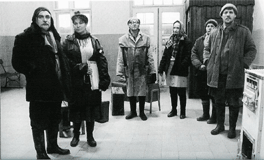 Bela Tarr's Satantango is notorious due to its exceptionally long (7
hour) running time, but the film deserves better than that. It's clearly a
masterpiece. Filmed in Hungary from 1991 to 1994, the work examines a village as
a microcosm of a country's political leanings. Through the luxury of such an
extravagant running time, Tarr is able to show a more complete picture of the
motivations, machinations, and manipulations behind political event than any
other film I can think of. There are clear reasons behind the happenings in the
film, but they are not easily labeled as "good" or "bad".
There's a definite, non-Hollywood, assertion that the working class consists
mainly of lemmings that ache to be controlled, if only to give their lives some
meaning. The film's villagers are cattle farmers, and they share with their
product an unquestioning pack mentality. The film says political process,
much like the revolutions that can overthrow it, are all part of a great cosmic
joke. The cycle of change brings only more of the same. Only a madman would
think change was capable of bringing something new.
Bela Tarr's Satantango is notorious due to its exceptionally long (7
hour) running time, but the film deserves better than that. It's clearly a
masterpiece. Filmed in Hungary from 1991 to 1994, the work examines a village as
a microcosm of a country's political leanings. Through the luxury of such an
extravagant running time, Tarr is able to show a more complete picture of the
motivations, machinations, and manipulations behind political event than any
other film I can think of. There are clear reasons behind the happenings in the
film, but they are not easily labeled as "good" or "bad".
There's a definite, non-Hollywood, assertion that the working class consists
mainly of lemmings that ache to be controlled, if only to give their lives some
meaning. The film's villagers are cattle farmers, and they share with their
product an unquestioning pack mentality. The film says political process,
much like the revolutions that can overthrow it, are all part of a great cosmic
joke. The cycle of change brings only more of the same. Only a madman would
think change was capable of bringing something new.
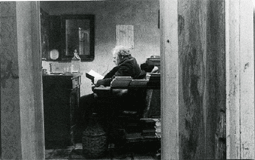 Just as the film eschews typical filmic moralizing and simplification, it
also casts off the typical language of film. The film's camera is far from
static, and cuts are so rare that each is a monumental event. This film feels
closer to the work of Ozu or Dreyer than to that of any of his contemporaries.
Tarr, like those directors, realizes the value of the long shot, which means he
must also understand the psychological importance of the cut to the audience. He
also overlaps time in the same way that Kubrick did in The Killing or
Tarrantino did in Jackie Brown. We see the same event happening from
several perspectives, each giving it greater importance. Furthermore, the film,
based on a Hungarian novel by the same name, adapts that novel's structure,
dividing the film into 12 "chapters". The narrative structure, which
is definitely closer to that of a novel than a film, contains the central
conceit that society, like the tango, takes six steps back for every six steps
forward. Still, I wouldn't want to make the film sound more unwieldy than it
actually is. Within that 12 chapter structure, there is a more cinematic three
act structure (the film is meant to be viewed with two intermissions), and each
of the three acts has a far different tone than the last, even as they comprise
a whole. It is tempting to say that the film is comprised of three smaller
movies (an exposť, a tragedy, a satire) but there is too much coherence in the
overall narrative arc to try to separate the acts in such a manner.
Just as the film eschews typical filmic moralizing and simplification, it
also casts off the typical language of film. The film's camera is far from
static, and cuts are so rare that each is a monumental event. This film feels
closer to the work of Ozu or Dreyer than to that of any of his contemporaries.
Tarr, like those directors, realizes the value of the long shot, which means he
must also understand the psychological importance of the cut to the audience. He
also overlaps time in the same way that Kubrick did in The Killing or
Tarrantino did in Jackie Brown. We see the same event happening from
several perspectives, each giving it greater importance. Furthermore, the film,
based on a Hungarian novel by the same name, adapts that novel's structure,
dividing the film into 12 "chapters". The narrative structure, which
is definitely closer to that of a novel than a film, contains the central
conceit that society, like the tango, takes six steps back for every six steps
forward. Still, I wouldn't want to make the film sound more unwieldy than it
actually is. Within that 12 chapter structure, there is a more cinematic three
act structure (the film is meant to be viewed with two intermissions), and each
of the three acts has a far different tone than the last, even as they comprise
a whole. It is tempting to say that the film is comprised of three smaller
movies (an exposť, a tragedy, a satire) but there is too much coherence in the
overall narrative arc to try to separate the acts in such a manner.
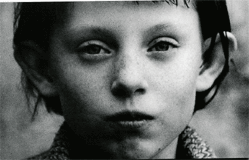 That main narrative arc covers a great deal of ground, and manages to show
the rise and fall of two separate political belief structures. The film begins
with the townsfolk's machinations as they attempt to cheat each other out of
their shares of a group cattle sale. These segments are filled with a multitude
of images, such as dirty sneakers, that suggest their form of capitalism is
corrupt. Each of them sees the money as a way to escape the confines of their
town. In order to break free from the system, the film says, they need to
exploit it. When Irimias, a great manipulator that the town thought dead,
returns to the city, their plans take pause. He is charged by the police to
become an informant. He agrees, seeing it as a way to exploit the system from
the inside. When a tragedy makes the town examine themselves, he quickly seizes
the opportunity to exploit them. In the film's final third, the satire becomes
far more pronounced as Irimias convinces the townspeople to form a commune so
that the community can avoid any further mishaps. They follow him, like
the cattle they have raised, into another microcosmic society that is doomed to
failure. Both the capitalist and communist societies in the film fail because of
the self-importance of the individual. The film basically sees no difference
between the two ethos, and gains a great deal of satiric power from that
observation.
That main narrative arc covers a great deal of ground, and manages to show
the rise and fall of two separate political belief structures. The film begins
with the townsfolk's machinations as they attempt to cheat each other out of
their shares of a group cattle sale. These segments are filled with a multitude
of images, such as dirty sneakers, that suggest their form of capitalism is
corrupt. Each of them sees the money as a way to escape the confines of their
town. In order to break free from the system, the film says, they need to
exploit it. When Irimias, a great manipulator that the town thought dead,
returns to the city, their plans take pause. He is charged by the police to
become an informant. He agrees, seeing it as a way to exploit the system from
the inside. When a tragedy makes the town examine themselves, he quickly seizes
the opportunity to exploit them. In the film's final third, the satire becomes
far more pronounced as Irimias convinces the townspeople to form a commune so
that the community can avoid any further mishaps. They follow him, like
the cattle they have raised, into another microcosmic society that is doomed to
failure. Both the capitalist and communist societies in the film fail because of
the self-importance of the individual. The film basically sees no difference
between the two ethos, and gains a great deal of satiric power from that
observation.
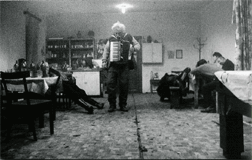 The film's two greatest sequences, however, seem to take place almost outside
the rest of the film. Both sequences feature outsiders that are caught spying on
the film's world. The first sequence features an obese hermit of a doctor that
is forced to leave his home to obtain more alcohol. It is probably the film's
longest sequence, and the lack of action on display takes on comic proportions.
The man's chaotic stumbling as he ventures out into the world becomes humorous
since he is so obviously ill-equipped to deal with the world, yet stands as its
critic. He was previously seen cataloguing his neighbors' actions with a
meticulous detail in his collection of notebooks. While he makes a drawing of
his view from his window, he consults a previous, similar drawing of the same
view. His actions here feel like historical revisionism, which is shocking since
he is the film's foremost chronicler of the world. He does not perceive the
world as it is, but rather how he has always wanted to see it. His justifies his
reclusive behavior by documenting the behavior of others, but the film suggests
his drunken chronicling is simply a defense mechanism.
The film's two greatest sequences, however, seem to take place almost outside
the rest of the film. Both sequences feature outsiders that are caught spying on
the film's world. The first sequence features an obese hermit of a doctor that
is forced to leave his home to obtain more alcohol. It is probably the film's
longest sequence, and the lack of action on display takes on comic proportions.
The man's chaotic stumbling as he ventures out into the world becomes humorous
since he is so obviously ill-equipped to deal with the world, yet stands as its
critic. He was previously seen cataloguing his neighbors' actions with a
meticulous detail in his collection of notebooks. While he makes a drawing of
his view from his window, he consults a previous, similar drawing of the same
view. His actions here feel like historical revisionism, which is shocking since
he is the film's foremost chronicler of the world. He does not perceive the
world as it is, but rather how he has always wanted to see it. His justifies his
reclusive behavior by documenting the behavior of others, but the film suggests
his drunken chronicling is simply a defense mechanism.
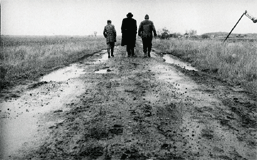 The film's best sequence is not as satiric as this, however. It's utterly
heartbreaking. The sequence follows a young girl as she comes to terms with the
world around her. It begins with the girl as she is tricked into giving away her
savings to her older brother. She returns home, and is scolded by her mother, a
prostitute, for spying on her. The girl then proceeds to torture her pet cat,
asserting the only power on the only being that she can. The portrait of
political impotence is horrifying here. She is unable to function in the world,
or even learn about it. Eventually, after finding out she was conned, her
situation escalates until a tragedy ensues. This sequence is possibly the most
sustained, tragic scene that I have seen in a political film. It propels a great
deal of the film's framework, and never once feels manipulative.
The film's best sequence is not as satiric as this, however. It's utterly
heartbreaking. The sequence follows a young girl as she comes to terms with the
world around her. It begins with the girl as she is tricked into giving away her
savings to her older brother. She returns home, and is scolded by her mother, a
prostitute, for spying on her. The girl then proceeds to torture her pet cat,
asserting the only power on the only being that she can. The portrait of
political impotence is horrifying here. She is unable to function in the world,
or even learn about it. Eventually, after finding out she was conned, her
situation escalates until a tragedy ensues. This sequence is possibly the most
sustained, tragic scene that I have seen in a political film. It propels a great
deal of the film's framework, and never once feels manipulative.
That can be said about the entire enterprise, however. The film is clearly
not interested in simply provoking the audience. It is much more concerned with
painting each outrage in the context of a contemptible whole. The film succeeds
brilliantly at doing so. Its exceptional running time is more than justified,
as it becomes necessary to show the procession of events as a procession of
decisions on its participants' behalf rather than a chain reaction caused by
uncontrollable circumstances. This would be next to impossible in a film that
tried to condense things. As it stands, Satantango is an exceptional work
that should be required viewing.
**** Masterpiece
October, 2001
Jeremy Heilman